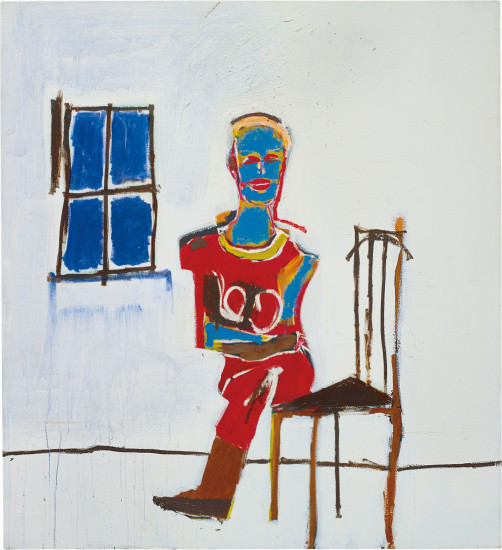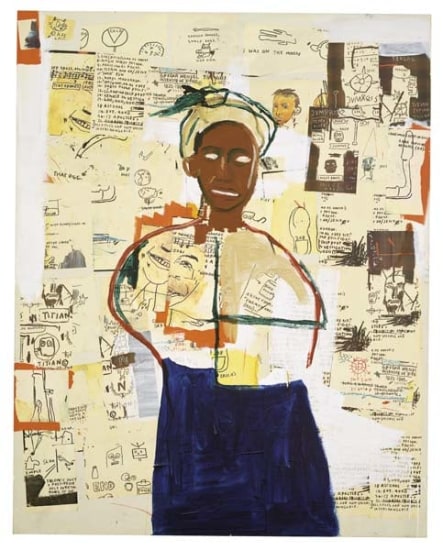30 Jean-Michel-Basquiat Untitled 1982 oilstick on paper 18 x 24 1/4 in. (45.7 x 61.6 cm) Signed and dated "82 Jean-Michel-Basquiat" on the reverse. This work is accompanied by a certificate of authenticity issued by the Authentication Committee of the Estate of Jean-Michel-Basquiat.
Provenance Annina Nosei Gallery, New York Private Collection New York, Christie's, Post-War and Contemporary Art, May 12, 2005, lot 555 Tony Shafrazi Gallery, New York Private Collection Exhibited New York, Tony Shafrazi Gallery, Four Friends, Jean-Michel-Basquiat, Keith Haring Donald Baechler Kenny Scharf October 25, 2007 - February 29, 2008 Portland, Portland Art Museum, Masterworks, December 18, 2012 - April 18, 2013 Catalogue Essay From oilstick to paper, Basquiat’s hand in drawing is a revelation: “He was compelled to tell the truth as he saw it and realize his vision, but his hypersensitivity, which was so innately connected to his process, detected many demons and enemies – some real, some exaggerated, and some imagined.” (Glenn O’Brien, Basquiat, Hatje Cantz, p.III). The present lot, an Untitled work from 1982, is no exception to Basquiat’s ingenious sense of color, form and line, all the while exuding this “hypersensitivity” known to the Radiant Child. Those who have witnessed Basquiat at work describe his drawings in particular as an activity - even a dance - rather than the mere application of medium. These works on paper, more than anything, show drawing as an experience of everyday life. Friend of the artist and frequent guest on Glenn O’Brien’s TV Party, Fab 5 Freddy describes the way Basquiat would hold his pencil or oilstick as untraditional: “He would stick it through the fourth finger and look really awkward, so that when he drew, the pencil would just kind of slip out of his hand. He’d let it go that way, then grab it and bring it down, then let it drift. It was amazing, this whole dance he did with the pencil.” (Fab 5 Freddy, quoted in Ingrid Sischy, “Jean-Michel Basquiat as Told by Fred Braithwaite," Interview 22 (October 1992), p. 119). Others describe the process as a manic obsession, having seen the artist squatting on the floor, the lines created by the gestural oilstick as organic visualization and rhythm rather than an artistic process. In Untitled, the black bodied bird’s sea-blue wings spanning the page, comes to form through the repetitive, bold strokes in combination with child-like cross-hatching. The sprawling wingspan of the bird, with a signature radiating halo above its head recalls the work on canvas Untitled (Fallen Angel) from the previous year. The bird in the present lot has now become further removed from the symbol of the fallen angel with the strong, dark silhouette of the blackbird taking center-stage. Upon deeper inspection, a pair of red hands appear from beyond the wings – another prominent motif within Basquiat’s distinct catalogue of imagery and iconography. Further, the votive symbol of the halo imbues the work with fallen idols. Within the edges of the wings, downward red arrows emerge further alluding to the fallen. This theme of divine or royal exile is whole-heartedly present in Basquiat’s oeuvre, often acting as an anecdote for the artist himself. Like the New York Times Magazine cover story, titled “New Art, New Money” from 1985, the artist dressed in a suit is enthroned yet barefoot, signalling Basquiat’s uniquely ambiguous identity. The year this work was created was arguably a key shift within Basquiat’s career. It was the year of his first solo show in the United States at Annina Nosei’s gallery. Later in the year, Basquiat is introduced to Andy Warhol with whom he later collaborates. Within the realm of the 1980s New York City art world, he was both an outsider yet crowned a prince. Perhaps most enlightening in context is the Psalm written by Basquiat in a rare notebook (Jean-Michel-Basquiat, “Untitled Notebook Page,” c. 1987) alluding to his addiction, his creative process and the artists own fallen-self: THIS IS NOT IN PRAISE OF POISON- ING MYSELF WAITING FOR IDEAS TO HAPPEN – MYSELF – THIS IS NOT IN PRAISE OF POISON THE NON POISONOUS POISONED SO SELF RIGHTOUS [sic] NO ONE IS CLEAN FROM RED MEAT TO WHITE … While the blackbird becomes a symbol of the fallen pri
30 Jean-Michel-Basquiat Untitled 1982 oilstick on paper 18 x 24 1/4 in. (45.7 x 61.6 cm) Signed and dated "82 Jean-Michel-Basquiat" on the reverse. This work is accompanied by a certificate of authenticity issued by the Authentication Committee of the Estate of Jean-Michel-Basquiat.
Provenance Annina Nosei Gallery, New York Private Collection New York, Christie's, Post-War and Contemporary Art, May 12, 2005, lot 555 Tony Shafrazi Gallery, New York Private Collection Exhibited New York, Tony Shafrazi Gallery, Four Friends, Jean-Michel-Basquiat, Keith Haring Donald Baechler Kenny Scharf October 25, 2007 - February 29, 2008 Portland, Portland Art Museum, Masterworks, December 18, 2012 - April 18, 2013 Catalogue Essay From oilstick to paper, Basquiat’s hand in drawing is a revelation: “He was compelled to tell the truth as he saw it and realize his vision, but his hypersensitivity, which was so innately connected to his process, detected many demons and enemies – some real, some exaggerated, and some imagined.” (Glenn O’Brien, Basquiat, Hatje Cantz, p.III). The present lot, an Untitled work from 1982, is no exception to Basquiat’s ingenious sense of color, form and line, all the while exuding this “hypersensitivity” known to the Radiant Child. Those who have witnessed Basquiat at work describe his drawings in particular as an activity - even a dance - rather than the mere application of medium. These works on paper, more than anything, show drawing as an experience of everyday life. Friend of the artist and frequent guest on Glenn O’Brien’s TV Party, Fab 5 Freddy describes the way Basquiat would hold his pencil or oilstick as untraditional: “He would stick it through the fourth finger and look really awkward, so that when he drew, the pencil would just kind of slip out of his hand. He’d let it go that way, then grab it and bring it down, then let it drift. It was amazing, this whole dance he did with the pencil.” (Fab 5 Freddy, quoted in Ingrid Sischy, “Jean-Michel Basquiat as Told by Fred Braithwaite," Interview 22 (October 1992), p. 119). Others describe the process as a manic obsession, having seen the artist squatting on the floor, the lines created by the gestural oilstick as organic visualization and rhythm rather than an artistic process. In Untitled, the black bodied bird’s sea-blue wings spanning the page, comes to form through the repetitive, bold strokes in combination with child-like cross-hatching. The sprawling wingspan of the bird, with a signature radiating halo above its head recalls the work on canvas Untitled (Fallen Angel) from the previous year. The bird in the present lot has now become further removed from the symbol of the fallen angel with the strong, dark silhouette of the blackbird taking center-stage. Upon deeper inspection, a pair of red hands appear from beyond the wings – another prominent motif within Basquiat’s distinct catalogue of imagery and iconography. Further, the votive symbol of the halo imbues the work with fallen idols. Within the edges of the wings, downward red arrows emerge further alluding to the fallen. This theme of divine or royal exile is whole-heartedly present in Basquiat’s oeuvre, often acting as an anecdote for the artist himself. Like the New York Times Magazine cover story, titled “New Art, New Money” from 1985, the artist dressed in a suit is enthroned yet barefoot, signalling Basquiat’s uniquely ambiguous identity. The year this work was created was arguably a key shift within Basquiat’s career. It was the year of his first solo show in the United States at Annina Nosei’s gallery. Later in the year, Basquiat is introduced to Andy Warhol with whom he later collaborates. Within the realm of the 1980s New York City art world, he was both an outsider yet crowned a prince. Perhaps most enlightening in context is the Psalm written by Basquiat in a rare notebook (Jean-Michel-Basquiat, “Untitled Notebook Page,” c. 1987) alluding to his addiction, his creative process and the artists own fallen-self: THIS IS NOT IN PRAISE OF POISON- ING MYSELF WAITING FOR IDEAS TO HAPPEN – MYSELF – THIS IS NOT IN PRAISE OF POISON THE NON POISONOUS POISONED SO SELF RIGHTOUS [sic] NO ONE IS CLEAN FROM RED MEAT TO WHITE … While the blackbird becomes a symbol of the fallen pri

.jpg)









Testen Sie LotSearch und seine Premium-Features 7 Tage - ohne Kosten!
Lassen Sie sich automatisch über neue Objekte in kommenden Auktionen benachrichtigen.
Suchauftrag anlegen